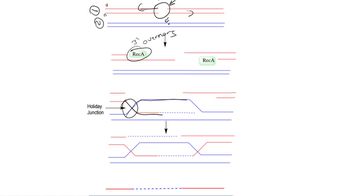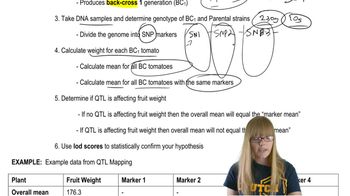Describe the temporal sequence of the bacteriophage life cycle.
Table of contents
- 1. Introduction to Genetics51m
- 2. Mendel's Laws of Inheritance3h 37m
- 3. Extensions to Mendelian Inheritance2h 41m
- 4. Genetic Mapping and Linkage2h 28m
- 5. Genetics of Bacteria and Viruses1h 21m
- 6. Chromosomal Variation1h 48m
- 7. DNA and Chromosome Structure56m
- 8. DNA Replication1h 10m
- 9. Mitosis and Meiosis1h 34m
- 10. Transcription1h 0m
- 11. Translation58m
- 12. Gene Regulation in Prokaryotes1h 19m
- 13. Gene Regulation in Eukaryotes44m
- 14. Genetic Control of Development44m
- 15. Genomes and Genomics1h 50m
- 16. Transposable Elements47m
- 17. Mutation, Repair, and Recombination1h 6m
- 18. Molecular Genetic Tools19m
- 19. Cancer Genetics29m
- 20. Quantitative Genetics1h 26m
- 21. Population Genetics50m
- 22. Evolutionary Genetics29m
5. Genetics of Bacteria and Viruses
Bacteriophage Genetics
Problem 1f
Textbook Question
In this chapter, we have focused on genetic systems present in bacteria and on the viruses that use bacteria as hosts (bacteriophages). In particular, we discussed mechanisms by which bacteria and their phages undergo genetic recombination, which allows geneticists to map bacterial and bacteriophage chromosomes. In the process, we found many opportunities to consider how this information was acquired. From the explanations given in the chapter, what answers would you propose to the following questions? How do we know that in bacteriophage T4 the rII locus is subdivided into two regions, or cistrons?
 Verified step by step guidance
Verified step by step guidance1
Understand the concept of a cistron: A cistron is a segment of DNA that codes for a single polypeptide chain or functional RNA. In the context of bacteriophage T4, the rII locus is a region of the genome that can be subdivided into two cistrons based on genetic and functional analysis.
Review the experimental approach used by Seymour Benzer: Benzer performed detailed genetic mapping experiments using bacteriophage T4. He infected E. coli with phages carrying mutations in the rII locus and analyzed the recombination events between these mutations.
Consider the complementation test: Benzer used a complementation test to determine whether two mutations in the rII locus affected the same functional unit (cistron). He co-infected E. coli with two phages, each carrying a different mutation in the rII locus. If the mutations were in different cistrons, the two phages could complement each other, allowing the infected bacteria to produce functional phage particles.
Analyze recombination frequency: Benzer also performed recombination experiments to map the relative positions of mutations within the rII locus. By analyzing the frequency of recombination between pairs of mutations, he was able to determine that the rII locus was subdivided into two distinct regions.
Conclude based on the data: The combination of complementation tests and recombination mapping provided strong evidence that the rII locus in bacteriophage T4 is subdivided into two cistrons. This conclusion was based on the observation that certain mutations could complement each other, while others could not, and the recombination data supported the physical separation of the two regions.
 Verified video answer for a similar problem:
Verified video answer for a similar problem:This video solution was recommended by our tutors as helpful for the problem above
Video duration:
1mPlay a video:
Was this helpful?
Key Concepts
Here are the essential concepts you must grasp in order to answer the question correctly.
Cistrons
Cistrons are segments of DNA that correspond to a single gene or functional unit within a genetic sequence. In the context of bacteriophages like T4, cistrons can be identified through genetic mapping techniques, which reveal how specific mutations affect the function of the virus. Understanding cistrons is crucial for determining how genetic information is organized and expressed in phages.
Genetic Recombination
Genetic recombination is a process by which genetic material is exchanged between different organisms or within the same organism, leading to new genetic combinations. In bacteriophages, recombination can occur during co-infection of a bacterial cell, allowing for the mapping of genetic loci like the rII locus in T4. This process is essential for understanding genetic diversity and the evolution of phages.
Recommended video:
Guided course

Recombination after Double Strand Breaks
Mapping Genetic Loci
Mapping genetic loci involves determining the positions of genes on a chromosome and understanding their relationships to one another. In bacteriophage T4, researchers use techniques such as complementation tests to ascertain the subdivision of the rII locus into two cistrons. This mapping is fundamental for genetic analysis and helps elucidate the functional roles of different genetic regions.
Recommended video:
Guided course

QTL Mapping

 3:44m
3:44mWatch next
Master Plaques and Experiments with a bite sized video explanation from Kylia
Start learningRelated Videos
Related Practice
Open Question
11
views
